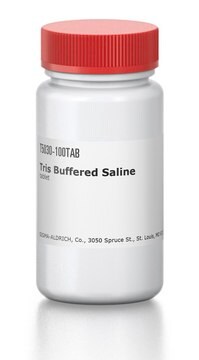480012
NDSB Set
Contains the following non-detergent sulfobetaines: 5 g of NDSB-195, 25 g of NDSB-201, and 5 g of NDSB-256.
Faça loginpara ver os preços organizacionais e de contrato
About This Item
Código UNSPSC:
12352200
NACRES:
NA.21
Produtos recomendados
Nível de qualidade
Formulário
solid
fabricante/nome comercial
Calbiochem®
condição de armazenamento
OK to freeze
desiccated (hygroscopic)
solubilidade
water: 50 mg/mL
Condições de expedição
ambient
temperatura de armazenamento
15-25°C
Descrição geral
Contains the following non-detergent sulfobetaines: 5 g of NDSB-195 (Cat. No. 480001), 25 g of NDSB-201 (Cat. No. 480005), and 5 g of NDSB-256 (Cat. No. 480010). Supplied with a data sheet.
Non-detergent sulfobetaines (NDSBs) are zwitterionic compounds. Like zwittergents (zwitterionic detergents), NDSBs carry the sulfobetaine hydrophilic head group. However, unlike zwittergents, the hydrophobic group in NDSBs is too short for micellar formation even at concentrations as high as 1M. Hence, NDSBs do not behave like detergents. Because of their zwitterionic nature, NDSBs were first employed to neutralize electrostatic interactions without increasing the conductivity in native isoelectrofocusing gels. Recently they have found utility in various other applications including isolation of membrane proteins, purification of nuclear proteins and halophilic proteins, renaturation of chemically and thermally denatured proteins and protein crystallization. They are potentially useful in solubilization and renaturation of fusion proteins from inclusion bodies. It is hypothesized that the hydrophobic group, although short, interacts with the hydrophobic regions of the protein preventing aggregation during renaturation. Also, presumably, the contribution from the short hydrophobic groups combined with charge neutralization ability of the sulfobetaine group results in higher yields of membrane proteins.
NDSBs do not interfere with enzymatic assays based on chromogenic substrates bearing nitrophenyl groups and do not inhibit the activities of β-galactosidase and alkaline phosphatase, the two enzymes tested thus far. NDSB-195 has the added advantage in that it does not absorb at 280 nm, making it compatible with protein purification procedures in which the protein concentrations are determined by absorbance measurements at 280 nm. Supplied with a data sheet.
NDSBs do not interfere with enzymatic assays based on chromogenic substrates bearing nitrophenyl groups and do not inhibit the activities of β-galactosidase and alkaline phosphatase, the two enzymes tested thus far. NDSB-195 has the added advantage in that it does not absorb at 280 nm, making it compatible with protein purification procedures in which the protein concentrations are determined by absorbance measurements at 280 nm. Supplied with a data sheet.
Advertência
Toxicity: Irritant (B)
Reconstituição
Store lyophilized products at room temperature. Following reconstitution, store in the refrigerator (4°C) or at room temperature (20°C).
Outras notas
Goldberg, M.E., et al. 1996. Folding and Design1, 21.
Goldberg, M.E., et al. 1995. Folding & Design1, 21.
Vuillard, L., et al. 1995. Biochem. J.305, 337.
Vuillard, L., et al. 1995. Anal. Biochem.230, 290.
Vuillard, L., et al. 1994. FEBS Lett.353, 294.
Goldberg, M.E., et al. 1995. Folding & Design1, 21.
Vuillard, L., et al. 1995. Biochem. J.305, 337.
Vuillard, L., et al. 1995. Anal. Biochem.230, 290.
Vuillard, L., et al. 1994. FEBS Lett.353, 294.
Informações legais
CALBIOCHEM is a registered trademark of Merck KGaA, Darmstadt, Germany
Código de classe de armazenamento
11 - Combustible Solids
Certificados de análise (COA)
Busque Certificados de análise (COA) digitando o Número do Lote do produto. Os números de lote e remessa podem ser encontrados no rótulo de um produto após a palavra “Lot” ou “Batch”.
Já possui este produto?
Encontre a documentação dos produtos que você adquiriu recentemente na biblioteca de documentos.
Nossa equipe de cientistas tem experiência em todas as áreas de pesquisa, incluindo Life Sciences, ciência de materiais, síntese química, cromatografia, química analítica e muitas outras.
Entre em contato com a assistência técnica








